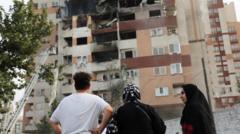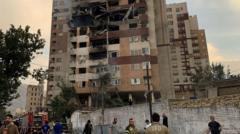Israel has conducted airstrikes on important Iranian nuclear facilities, including the Natanz uranium enrichment site, which has long been a focal point for international scrutiny and previous cyberattacks. The ramifications of these actions could extend far beyond the region.**
Escalation in the Middle East: Israel Strikes Target Iranian Nuclear Facilities**

Escalation in the Middle East: Israel Strikes Target Iranian Nuclear Facilities**
A significant military operation targeting Iran’s nuclear sites has raised global concerns about escalating tensions and the risks to regional security.**
In a bold military operation, Israel has launched airstrikes targeting key Iranian nuclear facilities, escalating tensions in the Middle East. The strikes were directed primarily at the Natanz site, a critical location for uranium enrichment, roughly 140 miles south of Tehran. This facility houses advanced centrifuges capable of producing highly enriched uranium essential for both civilian energy and nuclear weaponry.
Iran's extensive nuclear program, some of which is heavily fortified underground, presents significant challenges to any military operation. The recent assault appears to have caused substantial damage, with Rafael Grossi, head of the International Atomic Energy Agency (IAEA), confirming strikes at Natanz but reporting no radiation leaks thus far. Grossi condemned military actions against nuclear facilities, stating they pose serious risks to public safety and stability in the region.
While Natanz has faced attacks in the past, including the notorious Stuxnet cyber-attack in 2010, the current situation underscores a heightened military approach. Other critical sites include the fortified Fordow facility, rumored to be nearly impossible to penetrate without significant military cooperation, likely requiring U.S. assistance if targeted.
Moreover, the Parchin military complex and the only operational nuclear power plant, Bushehr, also represent focal points in Iran's nuclear ambitions. Despite Tehran’s insistence on the peaceful intent of its nuclear program, international concerns continue to escalate over the potential for weaponization.
The consequences of these airstrikes are anticipated to reverberate throughout the Middle East and beyond, prompting urgent discussions among global leaders regarding diplomatic resolutions and the broader implications for international security.
Iran's extensive nuclear program, some of which is heavily fortified underground, presents significant challenges to any military operation. The recent assault appears to have caused substantial damage, with Rafael Grossi, head of the International Atomic Energy Agency (IAEA), confirming strikes at Natanz but reporting no radiation leaks thus far. Grossi condemned military actions against nuclear facilities, stating they pose serious risks to public safety and stability in the region.
While Natanz has faced attacks in the past, including the notorious Stuxnet cyber-attack in 2010, the current situation underscores a heightened military approach. Other critical sites include the fortified Fordow facility, rumored to be nearly impossible to penetrate without significant military cooperation, likely requiring U.S. assistance if targeted.
Moreover, the Parchin military complex and the only operational nuclear power plant, Bushehr, also represent focal points in Iran's nuclear ambitions. Despite Tehran’s insistence on the peaceful intent of its nuclear program, international concerns continue to escalate over the potential for weaponization.
The consequences of these airstrikes are anticipated to reverberate throughout the Middle East and beyond, prompting urgent discussions among global leaders regarding diplomatic resolutions and the broader implications for international security.


















